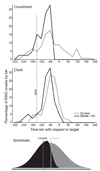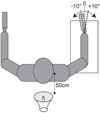Motor preparation is modulated by the resolution of the response timing information
- PMID: 20138165
- PMCID: PMC2839417
- DOI: 10.1016/j.brainres.2010.01.076
Motor preparation is modulated by the resolution of the response timing information
Abstract
In the present experiment, the temporal predictability of response time was systematically manipulated to examine its effect on the time course of motor pre-programming and release of the intended movement by an acoustic startle stimulus. Participants performed a ballistic right wrist extension task in four different temporal conditions: 1) a variable foreperiod simple RT task, 2) a fixed foreperiod simple RT task, 3) a low resolution countdown anticipation-timing task, and 4) a high resolution anticipation-timing task. For each task, a startling acoustic stimulus (124dB) was presented at several intervals prior to the "go" signal ("go" -150ms, -500ms, and -1500ms). Results from the startle trials showed that the time course of movement pre-programming was affected by the temporal uncertainty of the imperative "go" cue. These findings demonstrate that the resolution of the timing information regarding the response cue has a marked effect on the timing of movement preparation such that under conditions of low temporal resolution, participants plan the movement well in advance in accordance with the anticipated probability of onset of the cue, whereas movement preparation is delayed until less than 500ms prior to response time when continuous temporal information is provided.
Copyright 2010 Elsevier B.V. All rights reserved.
Figures








References
-
- Blumenthal TD, Cuthbert BN, Filion DL, Hackley S, Lipp OV, Van Boxtel A. Committee report: Guidelines for human startle eyeblink electromyographic studies. Psychophysiol. 2005;42:1–15. - PubMed
-
- Brown P, Rothwell JC, Thompson PD, Britton TC, Day BL, Marsden CD. New observations on the normal auditory startle reflex in man. Brain. 1991;114:1891–1902. - PubMed
-
- Buford JA, Davidson AG. Movement-related and preparatory activity in the reticulospinal system of the monkey. Exp. Brain Res. 2004;159:284–300. - PubMed
-
- Carlsen AN, Chua R, Inglis JT, Sanderson DJ, Franks IM. Startle response is dishabituated during a reaction time task. Exp. Brain Res. 2003;152:510–518. - PubMed
-
- Carlsen AN, Chua R, Inglis JT, Sanderson DJ, Franks IM. Prepared movements are elicited early by startle. J. Motor Behav. 2004a;36:253–264. - PubMed
Publication types
MeSH terms
Grants and funding
LinkOut - more resources
Full Text Sources

